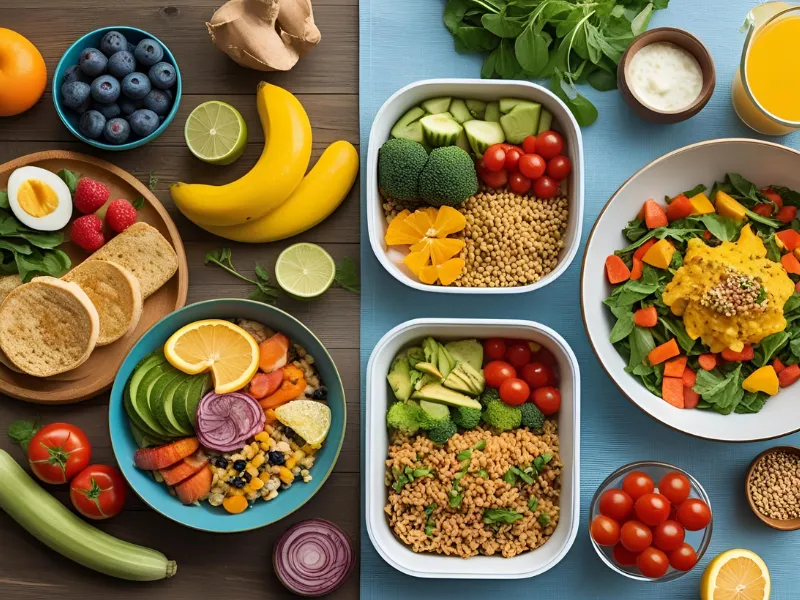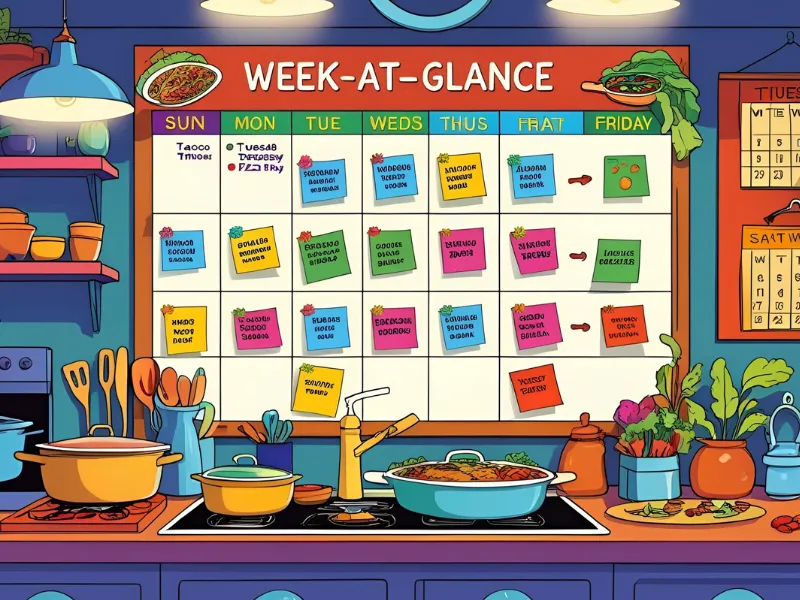Meal planning to save money is one of the most effective ways to reduce your grocery bills, minimize food waste, and enjoy less stressful mealtimes. With a few simple weekly habits, you can control spending, eat healthier, and avoid the daily “what’s for dinner?” dilemma.
If you’re wondering how to meal plan and save money without complicating your life, this guide will walk you through every step.
Key takeaways:
- Meal planning helps reduce food waste, save money, and cut back on takeout by providing structure to your weekly eating habits and ensuring you’re using what you already have at home.
- Following a simple 7-step process, from inventory checks to grocery list organization, makes meal planning approachable, even for beginners or those with unpredictable schedules.
- Budget-friendly meal plans can be tailored for individuals, families, or plant-based diets, showing that healthy, affordable eating doesn’t require expensive ingredients or daily cooking.
- Small changes like batch cooking, prioritizing expiring items, and using unit pricing lead to significant savings, with many households saving $100–$300 per month.
- Meal planning isn’t just a food strategy; it’s a financial tool, helping people redirect savings toward goals like debt repayment, emergency funds, or education investments.
1. Why meal planning saves you money
When I first started meal planning, I was overwhelmed by the idea of planning a full week of meals. Like many people, I often found myself staring into the fridge at 6 p.m. with no idea what to cook, and ending up ordering takeout.
Over time, I learned that with a little structure and preparation, meal planning to save money became not only doable but one of the best habits I adopted for my budget and peace of mind.
You don’t need to be a chef or an organization expert to plan meals. You just need a system that helps reduce impulsive spending and maximizes the use of what you already have.
1.1. The cost of not planning: impulse buys, food waste, and more
Shopping unprepared can lead to:
- Impulse purchases driven by hunger or store promotions
- Picking up things you didn’t realize were already in your pantry
- Food spoils before you use it
According to the Natural Resources Defense Council, the average American family wastes around $1,500 worth of food per year. That’s money thrown straight into the trash. A lack of planning is usually the reason.

1.2. How meal planning impacts your grocery budget and habits
Meal planning to save money creates structure and reduces unnecessary purchases. It helps you:
- Make meals using what’s already in your fridge and pantry.
- Cut back on expensive takeout or food delivery
- Reduce last-minute shopping trips
- Avoid buying duplicates or forgotten pantry items
The USDA reports that households that regularly plan meals can reduce grocery expenses by up to 25%. Over a year, that adds up to hundreds in savings.
2. 7 Simple steps to build a meal planning to save money
I followed this exact process myself and saw real savings within weeks, less food waste, fewer takeout meals, and a tighter grocery budget.
It’s worked wonders for me, and it might for you as well.
Here’s a simple guide on how to meal plan to save money, even if you’re just getting started.
Step 1: Take inventory of your fridge, freezer, and pantry
Start by identifying what ingredients you already have. This helps you avoid buying duplicates and allows you to build meals around what is available.
How to do it:
- Empty each shelf in your fridge, freezer, and pantry one section at a time.
- Create a list or spreadsheet of what you find, grouping items by type (e.g., dairy, vegetables, grains, proteins).
- Make a separate note of how much you have left of each item (e.g., half a bag of frozen peas, 4 eggs, one cup of rice).
For example, if you find a half-used jar of marinara sauce, pasta noodles, and frozen ground beef, you already have the base for a spaghetti dinner. No need to buy anything new for that meal.
Organizing your list this way makes it easier to plan meals that use what you already own.

Step 2: Highlight foods that are expiring soon
Prioritize using ingredients that are close to their expiration date. This prevents food waste and saves you from tossing out groceries you paid for.
Steps to follow:
- Check expiration dates on dairy, meats, and pre-packaged goods.
- Identify produce that is starting to wilt or become overripe.
- Circle or highlight these items on your inventory list.
Then, look for ways to use those items within the next two to three days. For instance, if you have spinach that’s starting to go limp, plan to use it in omelets, pasta, or as a side salad.
This method keeps your kitchen efficient and prevents loss due to spoiled food.
Step 3: Set a realistic weekly food budget
Your grocery budget should reflect your financial goals and your household size. A realistic, fixed budget keeps you disciplined and prevents overspending.
How to create your budget:
- Review your spending from the past month on groceries.
- Set a weekly target. For individuals, a common benchmark is $50 to $75 per week. For a family of four, it could range from $120 to $200, depending on dietary preferences.
- Divide your grocery budget by food types.
For example:
- $25 for proteins (meat, eggs, tofu)
- $20 for produce (vegetables and fruits)
- $10 for grains and pantry staples (rice, beans, pasta)
- $10 for dairy (milk, cheese, yogurt)
- $10 for flexible items (snacks, sauces, condiments)
Using cash or a prepaid grocery card can help keep your spending within these limits. Make this budget your foundation for meal planning.

Read more related articles:
Step 4: Choose your meal planning formula
There are several formats you can follow when planning meals. Choosing a method that fits your schedule makes it easier to maintain consistently.
Options include:
- Theme nights: Assign specific types of meals to specific days. For example, Meatless Monday, Taco Tuesday, Pasta Wednesday.
- Batch cooking: Prepare large quantities of one or two meals and portion them for multiple days. Cook on Sundays and refrigerate or freeze for the week.
- Leftovers-first strategy: Cook once and reuse components. A roasted chicken on Monday could become chicken salad for Tuesday and soup on Wednesday.
If you are often busy during the week, batch cooking might work best. If you enjoy variety and don’t mind cooking most nights, themed nights can bring structure while keeping things interesting.
Choose one system and try it for at least two weeks to see what works best for your routine.

Step 5: Create your meal plan with what you have
Use your inventory and planning method to build a practical meal plan. Focus on meals that reuse ingredients and avoid recipes that require specialty items you won’t use again.
How to build your plan:
- Begin by choosing 3 to 5 dinner recipes that match the ingredients you already have.
- Plan for easy meals on busy nights and more involved meals on weekends or days off.
- Include repeat ingredients across multiple meals. For example, bell peppers can be used in fajitas, pasta dishes, and stir-fries.
For a simple weekly plan:
- Breakfast: oatmeal with fruit, toast and eggs, yogurt with granola
- Lunch: leftovers from dinner, sandwiches, vegetable soup
- Dinner:
- Monday: vegetable stir-fry;
- Tuesday: spaghetti;
- Wednesday: chicken soup;
- Thursday: tacos;
- Friday: fried rice
Write the plan down using a meal planner to save money, a spreadsheet, or a calendar app to keep it visible throughout the week.
Step 6: Write your grocery list strategically
A well-organized grocery list saves time in the store and reduces the temptation to buy items you don’t need.
How to prepare your list:
- List only the ingredients needed to complete your planned meals.
- Organize the list by grocery store sections. For example:
- Produce: onions, carrots, spinach
- Dairy: milk, cheese, butter
- Pantry: oats, lentils, rice
- Protein: chicken, ground beef, eggs
- Check your inventory to confirm you don’t already have certain items.
Don’t stray from your grocery game plan. Avoid end-of-aisle promotional displays unless the item is on your list or can be substituted for an existing ingredient.
This focused approach ensures your shopping trip is efficient and budget-friendly.
Example: If tacos are on the menu, make sure you still have tortillas and cumin before adding them to your list.
Step 7: Shop smart with unit pricing and store brands
Maximize your grocery budget by learning how to compare products effectively while in the store.
How to shop smarter:
- Look at the unit price labels on shelves. This shows the price per ounce, pound, or liter, helping you find the best value.
- Choose store brands over national brands whenever possible. Many are made by the same manufacturers but sold at a lower price.
- Shop on store discount days or use digital coupons from your grocery store’s app.
- Consider buying staple items in bulk if you use them regularly and have storage space.
For example, a two-pound bag of brown rice with a unit price of $0.80 per pound is a better deal than a one-pound bag at $1.25 per pound.
Use the receipt from your shopping trip to track spending and compare with your budget. Over time, you’ll become more efficient at identifying savings.

3. Budget-friendly meal plan examples
Creating a cost-effective meal plan doesn’t mean sacrificing nutrition or variety. Below are examples that show how meal planning to save money works in real-world situations, whether you’re cooking for one, a family, or following a plant-based diet.
3.1. Sample 3-day meal plan for $30
This plan assumes you already have some basic staples like salt, pepper, oil, and spices.
Day 1
- Breakfast: Oatmeal with banana
- Lunch: Lentil soup with bread
- Dinner: Spaghetti with tomato sauce and frozen vegetables
Day 2
- Breakfast: Scrambled eggs with toast
- Lunch: Tuna salad sandwich and carrot sticks
- Dinner: Rice stir-fry with eggs and leftover vegetables
Day 3
- Breakfast: Yogurt with oats and chopped apple
- Lunch: Leftover lentil soup
- Dinner: Baked potatoes with beans and steamed broccoli
Shopping tips for this plan:
- Buy in bulk where possible (e.g., oats, rice, lentils)
- Choose store-brand canned beans and pasta
- Select frozen vegetables for variety and value

3.2. 1-week meal plan for families (under $75)
Designed for two adults and two children, this plan emphasizes affordable family favorites and leftover repurposing.
Highlights:
- Cook once, eat twice (roast chicken becomes soup)
- Use large batches of rice, pasta, or potatoes
- Plan 2 meatless nights
Sample dinners:
- Monday: Baked chicken thighs with potatoes and green beans
- Tuesday: Chicken noodle soup with toast
- Wednesday: Pasta with marinara sauce and roasted carrots
- Thursday: Vegetable stir-fry with rice
- Friday: Homemade pizza on store-bought dough
- Saturday: Leftovers buffet
- Sunday: Breakfast-for-dinner (pancakes, eggs, fruit)
Estimated breakdown:
- Proteins: $25
- Produce: $20
- Grains and pantry: $15
- Dairy and extras: $15
3.3. Vegetarian and plant-based affordable meal options
Plant-based meal planning can be both healthy and economical, especially when focused on whole foods.
Inexpensive staples to include:
- Lentils, chickpeas, black beans
- Rice, quinoa, and oats
- Sweet potatoes, cabbage, and carrots
Example weekly vegetarian dinners:
- Lentil curry with rice
- Chickpea salad wraps
- Vegetable and tofu stir-fry
- Pasta primavera with olive oil and garlic
- Baked sweet potatoes with black bean salsa
- Vegan chili with cornbread
- Stir-fried cabbage and noodles
Buying dried legumes and frozen vegetables in bulk will stretch your dollar even further.
4. Tips to maximize savings with meal planning
Minor changes now mean major savings later. These strategies help you get more out of every dollar and every ingredient.
4.1. Cook once, eat twice
Make meals that can stretch into future servings.
Ideas to implement this:
- Roast extra vegetables for future wraps or omelets
- Double soup or stew recipes and freeze half
- Make large casseroles to reheat for lunch
This approach reduces cooking time and lowers food waste.
4.2. Batch cooking and freezing tips
Batch cooking is one of the most efficient ways to control food spending while maintaining variety.
How to start:
- Choose one or two meals to cook in bulk (e.g., chili, lasagna)
- Portion into containers and freeze in meal-sized servings
- Label containers with the date to use them in rotation
Freezer-friendly meals are a buffer against costly takeout on busy nights.

4.3. Low-cost, high-impact pantry staples to always keep
Keep a stock of versatile ingredients that form the base of many meals.
Recommended staples:
- Rice, oats, and pasta
- Canned tomatoes and beans
- Dried lentils and split peas
- Onions, garlic, and potatoes
- Peanut butter and eggs
These items provide a solid foundation for countless dishes and help reduce trips to the store.
4.4. Best budget-friendly kitchen tools
Some tools pay for themselves quickly by making prep and cooking more efficient.
Suggested tools:
- Slow cooker or rice cooker
- Sharp chef’s knife and cutting board
- Freezer-safe containers
- Measuring cups and spoons
- Vegetable peeler and grater
These tools help save time and reduce waste, especially when preparing meals in batches.
5. Common mistakes to avoid when meal planning on a budget
Even with the best intentions, some planning habits can backfire and waste money.
Overcomplicating your meals: Avoid recipes with too many unusual ingredients or steps.
Tip: Stick with familiar recipes or use simple ingredient swaps to stay on track.
Buying ingredients you won’t use again: Specialty sauces or spices for one-time use often go to waste.
Tip: Only try new ingredients if you have multiple recipes that call for them.
Not accounting for schedule changes: Meal plans fail when they ignore real-life changes.
Tip: Always include one or two flexible meals that require minimal prep and can be used any night.
6. Expert advice: How real families save $100+ per month
Hearing from people who practice meal planning to save money can be more motivating than any statistic.
Quotes from experts and real households:
- Anna Taylor, Registered Dietitian at the Cleveland Clinic, says:
“Planning meals each week not only improves nutrition but is one of the most effective ways to control grocery costs.” - Jessica Ramirez, mom of three in Texas, shares:
“We saved nearly $150 a month by cooking from a set plan. I repeat meals every other week and shop with a calculator.” - Lisa Andrews, nutrition coach, recommends:
“Shop your pantry first. That one change helps my clients reduce their food waste and spending dramatically.”
Real-life strategies include:
- Tracking grocery receipts
- Using cash envelopes for food budgets
- Sharing meal prep with family members to reduce burnout
7. Turning your food savings into financial wins
Meal planning to save money isn’t just about cutting costs; it’s about turning everyday habits into real financial progress.
Take Jasmine, a single mom in Atlanta. She used to spend over $800 a month on groceries and takeout. After switching to weekly meal planning and cooking in batches every Sunday, her food bill dropped to $550. That’s a $250 monthly savings.
Instead of spending that extra cash, Jasmine focused it on one goal: paying off a $1,200 credit card. In less than five months, she wiped out the balance, just by using the money she saved from the kitchen.
“Every week I meal prepped, I felt like I was also paying off my debt,” she shared.
Now Jasmine is building an emergency fund and saving for an online course to upgrade her skills. What started as a grocery habit became a stepping stone toward a more stable future.
This is what we call the “kitchen-to-cashflow” mindset. Small wins at home can fund bigger goals, whether it’s clearing debt, saving, or investing in yourself.
8. FAQs
On average, households save between $100 and $300 per month, depending on family size and starting habits.
Not necessarily. Many people cook two or three times per week and rely on leftovers or freezer meals in between.
No. Single individuals and couples benefit just as much. Planning helps avoid waste from forgotten perishables and repeated trips to the store.
Choose flexible meals like frozen stir-fry kits, canned soups, or breakfast-for-dinner options. Keep ingredients on hand for backup meals.
Repeat favorite meals with small variations. For example, switch between beef, tofu, or chicken in stir-fries.
9. Conclusion
Personally, once I committed to planning just three days in advance instead of trying to plan the entire week, I saw immediate results. I stopped overbuying groceries, and my food waste dropped to nearly zero. More importantly, I felt less stressed every evening, knowing dinner was already decided.
Meal planning to save money is a habit that brings real, measurable rewards. From cutting down grocery bills and reducing food waste to making mealtime less stressful, the benefits go far beyond the dinner table. With a little upfront effort and a clear plan, you can take control of your kitchen, your time, and your budget.
If you’re ready to start, begin with a 3-day plan, shop your pantry, and give yourself space to adjust. Every small change adds up, and the savings can be significant.
If you’re ready to take your financial habits to the next level, explore our Cash Flow & Saving Strategies at H2T Funding, where we share more tips on budgeting, saving, and smart spending for everyday life.





